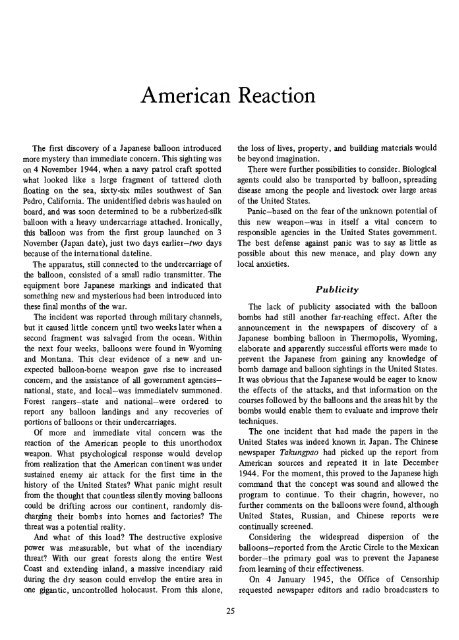Balloon Bomb - Smithsonian Institution Libraries
Balloon Bomb - Smithsonian Institution Libraries
Balloon Bomb - Smithsonian Institution Libraries
You also want an ePaper? Increase the reach of your titles
YUMPU automatically turns print PDFs into web optimized ePapers that Google loves.
American Reaction<br />
The first discovery of a Japanese balloon introduced<br />
more mystery than immediate concern. This sighting was<br />
on 4 November 1944, when a navy patrol craft spotted<br />
what looked like a large fragment of tattered cloth<br />
floating on the sea, sixty-six miles southwest of San<br />
Pedro, California. The unidentified debris was hauled on<br />
board, and was soon determined to be a rubberized-silk<br />
balloon with a heavy undercarriage attached. Ironically,<br />
this balloon was from the first group launched on 3<br />
November (Japan date), just two days earlier—two days<br />
because of the international dateline.<br />
The apparatus, still connected to the undercarriage of<br />
the balloon, consisted of a small radio transmitter. The<br />
equipment bore Japanese markings and indicated that<br />
something new and mysterious had been introduced into<br />
these finalmonths of the war.<br />
The incident was reported through military channels,<br />
but it caused little concern until two weeks later when a<br />
second fragment was salvaged from the ocean. Within<br />
the next four weeks, balloons were found in Wyoming<br />
and Montana. This clear evidence of a new and unexpected<br />
balloon-borne weapon gave rise to increased<br />
concern, and the assistance of all government agenciesnational,<br />
state, and local—was immediatelv summoned.<br />
Forest rangers—state and national—were ordered to<br />
report any balloon landings and any recoveries of<br />
portions of balloons or their undercarriages.<br />
Of more and immediate vital concern was the<br />
reaction of the American people to this unorthodox<br />
weapon. What psychological response would develop<br />
from realization that the American continent was under<br />
sustained enemy air attack for the first time in the<br />
history of the United States? What panic might result<br />
from the thought that countless silently moving balloons<br />
could be drifting across our continent, randomly discharging<br />
their bombs into homes and factories? The<br />
threat was a potential reality.<br />
And what of this load? The destructive explosive<br />
power was measurable, but what of the incendiary<br />
threat? With our great forests along the entire West<br />
Coast and extending inland, a massive incendiary raid<br />
during the dry season could envelop the entire area in<br />
one gigantic, uncontrolled holocaust. From this alone,<br />
the loss of lives, property, and building materials would<br />
be beyond imagination.<br />
There were further possibilities to consider. Biological<br />
agents could also be transported by balloon, spreading<br />
disease among the people and livestock over large areas<br />
of the United States.<br />
Panic-based on the fear of the unknown potential of<br />
this new weapon-was in itself a vital concern to<br />
responsible agencies in the United States government.<br />
The best defense against panic was to say as little as<br />
possible about this new menace, and play down any<br />
local anxieties.<br />
Publicity<br />
The lack of publicity associated with the balloon<br />
bombs had still another far-reaching effect. After the<br />
announcement in the newspapers of discovery of a<br />
Japanese bombing balloon in Thermopolis, Wyoming,<br />
elaborate and apparently successful efforts were made to<br />
prevent the Japanese from gaining any knowledge of<br />
bomb damage and balloon sightings in the United States.<br />
It was obvious that the Japanese would be eager to know<br />
the effects of the attacks, and that information on the<br />
courses followed by the balloons and the areas hit by the<br />
bombs would enable them to evaluate and improve their<br />
techniques.<br />
The one incident that had made the papers in the<br />
United States was indeed known in Japan. The Chinese<br />
newspaper Takungpao had picked up the report from<br />
American sources and repeated it in late December<br />
1944. For the moment, this proved to the Japanese high<br />
command that the concept was sound and allowed the<br />
program to continue. To their chagrin, however, no<br />
further comments on the balloons were found, although<br />
United States, Russian, and Chinese reports were<br />
continually screened.<br />
Considering the widespread dispersion of the<br />
balloons—reported from the Arctic Circle to the Mexican<br />
border—the primary goal was to prevent the Japanese<br />
from learning of their effectiveness.<br />
On 4 January 1945, the Office of Censorship<br />
requested newspaper editors and radio broadcasters to<br />
25
















